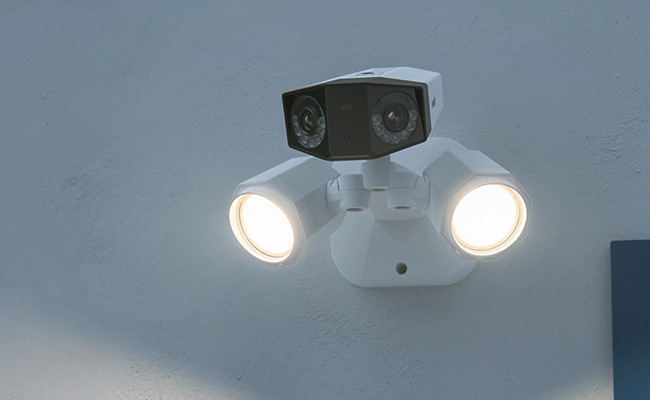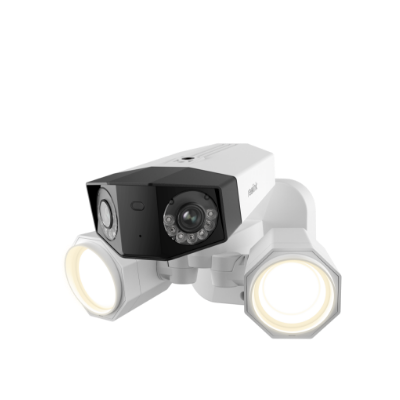How to Install Floodlight Camera: Step-By-Step Guide

Are you looking to enhance the security of your home or property while enjoying the convenience of advanced surveillance technology? Installing a floodlight camera is an innovative and proactive step in safeguarding your surroundings. This comprehensive guide will show you the step-by-step process of installing a floodlight camera, ensuring you can protect your home against intruders, monitor your property remotely, and enjoy peace of mind.
Note: Before installing, choosing the right camera model can somehow facilitate the installation process. Check out our comprehensive home security camera buying guide.
How to Install a Floodlight Camera
Installing a floodlight camera is easier than you might imagine. Here are some straightforward steps to get you started.
1. Choose the right location
The location should be at least a minimum of nine feet off the ground to allow for the most efficient illumination of the floodlight. And the place should strike a balance between the best angle of lighting and camera filming.
2. Turn off the power before starting
Safety remains the priority for any installation. You must head to your circuit breaker box, locate the switch for your outdoor power sources, and flip it to the OFF position before installing.
3. Mount the bracket
The bracket holds the whole system, including the light and the camera. You need to mount the bracket on the wall or attach it to other places at a certain height.
4. Connect the floodlight cam to existing wires
You need to make sure that you match the wires of the new fixture to the existing wires in your home by colors. After that, tape them together, plug the bulb into the fixture, and finally turn on the power to test them to see whether they are installed correctly.
5. Add the floodlight
Some floodlight camera models require separate installation for the lighting fixture and the camera. You can place the camera first and add the floodlight if you have such models. Use a mounting template to mark the places for drilling holes, and then use drills to make holes in the place where the light fixture is installed. Then, locate a junction box near the mounting area and use the fish tape to run wires through the tube to connect the camera and floodlight.
6. Seal the junction box
After combining the two parts, you can seal all the wires in the junction box. This box can help keep water or other pollutants from the cables, extend the lifespan, and secure the stability of the whole system.
7. Test the floodlight camera
Once the installation is complete, check whether your camera is working correctly. You can also adjust the optimum angle of the camera and set up the proper illumination for the maximum brightness effect. Then, turn on the camera again. If everything is working in order, then the installation process is complete.
You can check the video below for more information about installing a floodlight camera.
Installing Floodlight Cam without Existing Wiring
In most cases, floodlight cameras can be connected to existing wiring. However, check out the following steps to install the floodlight cam without existing wiring.
Some tools and materials required for this installation process include:
- Gauge wire
- 2-inch UF adapter
- Junction box
- Power drill
- Staples for wire
- Single pull switch and cover
After gathering all these materials, let's jump in on the steps involved in installing the floodlight camera.
- Find a power source. The first step is to locate a power source for powering the floodlight camera.
- Connect new wires. It would help if you connected the new wires to the hot and neutral ends. Twist the ground wires together and feed them into a single ground wire location.
- Install new junction box. Drill holes near the junction box and twist the wire from the junction box to the switch.
- Mount the bracket. Please put in place the mounting bracket on the junction box. The box can make the whole system stay put.
- Connect the wires. Connect the copper ground wire from the floodlight cam to the bracket's green ground screw and the junction box's existing ground wire. Remember to use a supplied wire nut to join the wires together.
- Finish the installation and test the system. You can test the floodlights to determine whether they are at the perfect angle. You can also make slight adjustments to the camera, ensuring the camera is in the proper position.
Cost of Floodlight for Security Camera
While the price depends mainly on the models you've chosen and the cost of hiring electricians, the average price for installing an outdoor floodlight nationwide is about $450. Most people spend between $250 and $800 on the installation process. If you also include the camera installation, the total cost can reach $300 to $850.
Benefits of Adding Floodlight to Security Camera
Floodlights can enhance the overall performance of security cameras in the following aspects.
Enhanced visibility
Floodlight can illuminate the area around the security camera and ensure it captures clear, high-quality video footage, even in low-light or nighttime conditions. The additional lighting can improve the effectiveness of the camera for surveillance purposes.
Deterrence
Bright floodlights can act as a deterrent to potential intruders or trespassers. When motion is detected, the sudden illumination of the area can startle individuals and make them rethink their intentions, reducing the likelihood of criminal activity.
Extended coverage
By adding floodlights, you can extend the coverage area of your security camera. The well-lit surroundings allow the camera to capture video footage over a larger, more well-defined area, reducing blind spots.
Increased security
Floodlights can provide homeowners or security personnel with valuable information. Modern floodlight cameras will light up when suspicious activities are detected. With remote accessibility, you can activate or deactivate the lights, check live camera feeds, and receive alerts on your mobile device, providing peace of mind and control from anywhere.
Lumens for Floodlight: Illuminate the Night
Regarding lighting, some terms may confuse you, such as "lumen" and how many lumens security cameras need. Here's the explanation below.
What are lumens?
Lumens, in the context of floodlight cameras, refer to the measurement of the total amount of visible light emitted by the floodlights. It is a unit of measure used to quantify the brightness or intensity of the light produced by the floodlight. More lumens means it's a brighter light; fewer lumens means it's a dimmer light.
How many lumens do floodlight cameras need?
The number of lumens required for a floodlight camera depends on various factors, including the specific area you want to illuminate, your security needs, and your preferences. A floodlight camera with 700 to 1,300 lumens can be sufficient for small residential areas like doorways, porches, or driveways. For medium-sized places such as larger driveways. If you have ample outdoor space or need to illuminate a considerable distance, opt for floodlight cameras with a rating of 2,500 lumens or more. This level of brightness ensures better visibility over a more immense expanse.
Best Floodlight Camera Recommendation: Reolink Duo Floodlight PoE/WiFi
With the development of technology, a wealth of floodlight cameras is emerging in the market. They not only have beautiful appearance but also powerful functions.
Reolink Duo Floodlight Camera features an astounding 180°viewing angle with two lenses, and the images captured by two cameras can be integrated into one for a better visual experience. You can choose PoE version or WiFi version according to your individual needs. The floodlight is effective for detecting suspicious moves and objects. The floodlights can be triggered automatically when people or vehicles are detected. You can also select other activation modes for your lights or schedule your lights to turn on and off at specific times.
4K PoE Floodlight Camera
Dual Lens, Power over Ethernet, 180° Wide-Angle Panorama, 1800 Lumen Floodlights
With 4K 8MP resolution, you can access unparalleled clarity from anywhere via the Reolink app or Client. Thanks to the advanced AI algorithms, the Reolink Floodlight Camera accurately detects people and vehicles and recognizes pets. When it detects anything suspicious, the floodlights and siren activate automatically, and you can promptly respond using the built-in microphone and speaker.
FAQs
Do I need an electrician to install floodlight cameras?
No, you can handle the installation process all by yourselves. Plenty of online resources can help walk you through the step-by-step installation process. However, if you need more clarification about your installation techniques, you can hire a professional to install a floodlight cam.
Can I install floodlights by myself?
Yes. Installing a floodlight cam is relatively easy because you can find the installation guide easily on the Internet and do it independently. Still, it would help if you took all necessary precautions to keep yourself safe.
Where is the best place to put a floodlight camera?
The best placement for a floodlight camera depends on your specific security and surveillance needs, as well as the layout of your property. Aim your floodlight cam at the area where you first want to be alerted, and the optimal motion zone of the cam should overlay the perimeter of your property.
Should the floodlight be above or below the camera?
While both above and below camera placement can work, positioning the floodlight above the camera is generally the preferred option for minimizing glare and ensuring even illumination. But the floodlight of many camera models is fixed, and the position can not be changed. If you want to add a floodlight to your security camera, consider putting the light above the camera.
Conclusion
Floodlight cameras can enhance home security across the board, demonstrating several advantages, such as flexibility, waterproofness, and all-weather monitoring. When installing the camera, you can follow the general steps mentioned above. It is time to get started to install your floodlight cameras! Do you have any more insights? Please keep us informed by commenting below. We would appreciate your sharing it with your friends and family.
Search
Be in the Know
Security insights & offers right into your inbox

